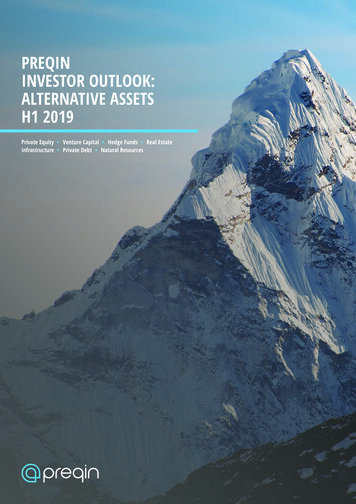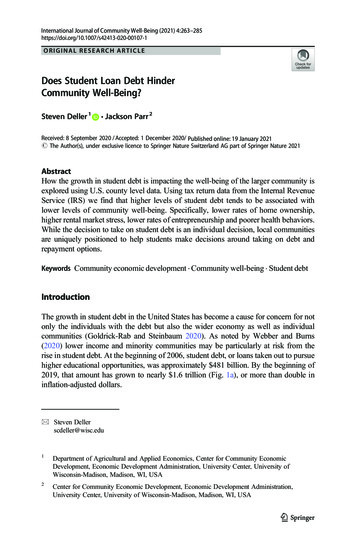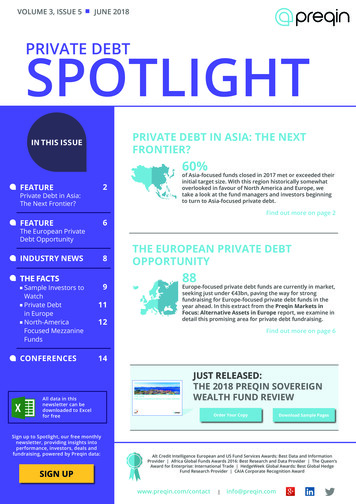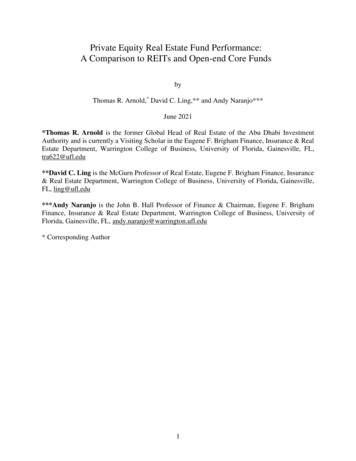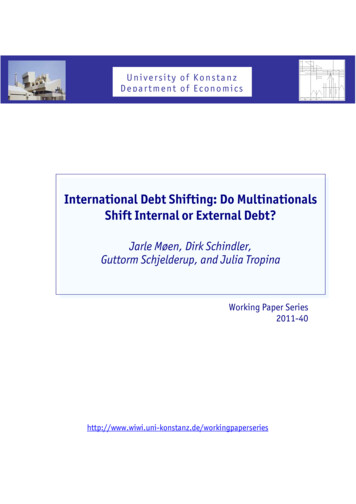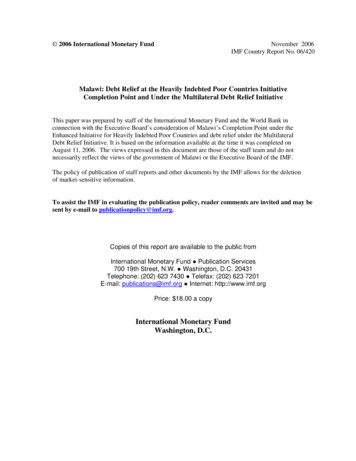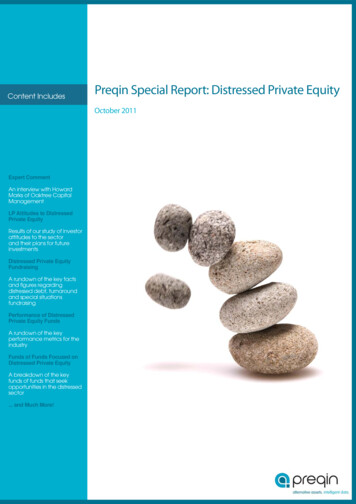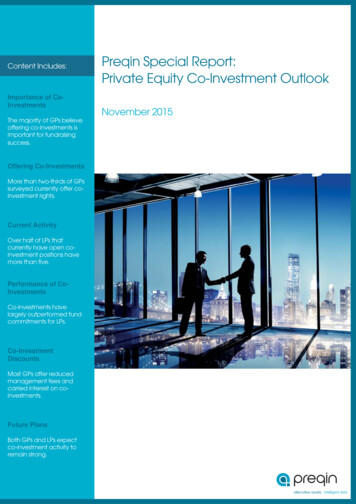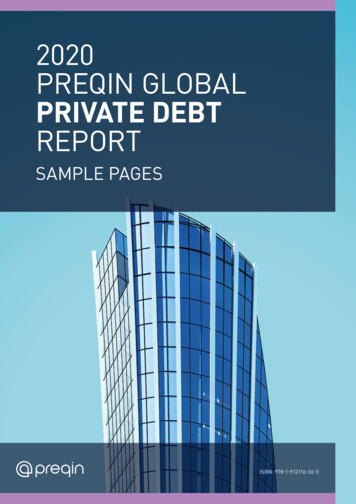
Transcription
2020PREQIN GLOBALPRIVATE DEBTREPORTSAMPLE PAGESISBN: 978-1-912116-26-3
2020 PREQIN GLOBAL PRIVATE DEBT REPORT – SAMPLE PAGESContents3CEO's Foreword – Mark O'Hare, Preqin5. Investors4Selectivity Is Key in Private Debt – Ken Kencel,Churchill Asset Management, a Nuveen company38Investor Universe6Why Investors Should Focus on Outcomes, NotDefinitions – Jo Waldron, M&G Investments39Future Searches and Mandates40Large Investors Seek Alternative Structures42In Focus: Rise of Covenant-Lite Loans1. Overview of the Industry10Executive Summary11Private Debt Megatrends12Private Debt in 2019: Key Facts6. Deals44The Mainstreaming of Private Credit inIndia – Hemant Daga, Edelweiss Global AssetManagement46Deals Drop off but Managers Break New Ground2. Assets under Management14Five Forces Shaping the Future of Private Credit– Jirí Król, Alternative Investment ManagementAssociation 15Managers Find Opportunity as AUM Rises18Capital Calls and Distributions3. Fundraising20Fundraising: Established Managers Flourish inPrivate Debt23Funds in Market Reach All-Time High25China's Real Estate Market Offers PromisingDistressed Debt Opportunities – Xiaolin Zhang &Zheng Zhang, Lakeshore Capital27In Focus: The Rise of Asian Private Debt7. Performance50Rising Competition Weighs on Performance52Horizon IRRs54Performance Benchmarks and PMEs8. League Tables58Largest Fund Managers63Largest Funds Closed65Top Performers67Largest Investors9. Regions70North America72Europe4. Fund Managers74Asia30When the Check Alone Isn’t Enough – AlexSchmid, ESO Capital76Rest of World31The Expanding Fund Manager Universe33In Focus: First-Time Funds Struggle to Raise35Fund Terms210. Outlook80Six Principles for Successful Alternative CreditInvestments in Emerging Markets – Nabil MarcAbdul-Massih, INOKS Capital82In Focus: ESG, Slow and Steady84Outlook for Private Debt in 202087Preqin Predictions
2020 PREQIN GLOBAL PRIVATE DEBT REPORT – SAMPLE PAGES1. OVERVIEW OF THE INDUSTRYExecutive SummaryAssets under management in private debt have once again hit a record, but the assetclass has become more nuancedArguably the youngest asset class in the private capitaluniverse, private debt has soared to incredible heightssince the Global Financial Crisis (GFC). Assets undermanagement (AUM) have grown consistently each yearand, as of June 2019, reached a record 812bn. Privatedebt is now the third-largest asset class in privatecapital, ahead of infrastructure and natural resources.The market has continuously expanded ever sincethe GFC, when banks retrenched from serving themiddle market as they derisked their balance sheets.Private debt firms swooped in to capitalize on the voidin the middle market. Over 4,100 investors now makeallocations to the asset class. Demand has given rise toa record 1,764 fund managers now active in the space– up from 1,604 at the beginning of 2019 and over twiceas many as five years ago – and a significant pool ofcapital available for them to put to use.And put it to use they have. In tandem with growthin AUM, dry powder had been rising for the pastfive years; but in 2019, dry powder levels flattenedsomewhat, rising by only 4bn, from 292bn at the endof 2018 to 296bn as of December 2019, despite an 8%increase in overall AUM.A total of 151 private debt funds closed to raise acombined 104bn, down from 110bn in 2018 through210 fund closures, which in turn was down from therecord 132bn secured through 220 fund closures in2017. The 10 largest funds closed in 2019 raised 36%of total capital, an increase of seven percentage pointsin comparison to the previous year, highlighting theexistence of capital consolidation as investors areincreasingly drawn to larger, more established fundmanagers.10The uncertainty surrounding the current economicand credit cycle is undoubtedly a key consideration formany players in the private debt industry. In a low-yieldenvironment, investors require fund managers withthe capability and resources to adequately deal withdistressed loans, and therefore may be drawn to moreexperienced managers with stronger track records inthe event of a market downturn. Newer managers canstill offer opportunity in these times, however; indeed,first-time fundraising made up 9% of total capitalraised in private debt in 2019, up from 7% at the end of2018.Looking ahead, investors are upbeat about their privatedebt portfolios. A significant 91% of investors we spoketo will either maintain or increase their allocation toprivate debt over the longer term. That said, challengeslie in wait. While investors may be seeking downsideprotection, private debt has not been tested througha full market cycle. This is where managers will wantto provide more transparency around investmentdecisions, to convince stakeholders of the value theasset class can deliver even if there are difficult timesahead.
2020 PREQIN GLOBAL PRIVATE DEBT REPORT – SAMPLE PAGES1. OVERVIEW OF THE INDUSTRYPrivate DebtMegatrendsKey themes shaping the private debt industryCompetition for DealsCapital ConcentrationAs AUM continues to rise, the challenge for managersis to find value in an increasingly competitive dealmaking environment.The larger fund managers are absorbing more industrycapital as investors seek out established managers fordownside protection.Rise of Covenant-LiteMarket SlowdownCovenants on loans have become looser as managersattempt to circumvent heightened competition in themarket.A market slowdown is widely believed to be on thehorizon and stakeholders in the industry are preparingaccordingly.Data PackESGESG is the hot topic in alternatives. We are seeing astructural shift in the attitudes of private debt investorstoward ESG.The data behind all of the charts and tablesfeatured in this report is available in Excel format atno extra cost. This data may be used in marketingmaterials, presentations, or company reports withappropriate accreditation to Preqin. Preqin Ltd. www.preqin.com11
2020 PREQIN GLOBAL PRIVATE DEBT REPORT – SAMPLE PAGESSPONSOREDSelectivity Is Key inPrivate DebtChurchill, the private capital affiliate of Nuveen, on the key opportunities in theprivate debt market and the importance of selectivity and diversification in portfoliodevelopmentIn which areas are you seeing the most attractiveopportunities in the private debt market?We are focused on investing in directly originated seniorsecured loans to private equity-backed, traditionalmiddle-market companies ( 10-50mn of EBITDA),which we believe provide an attractive risk/returnopportunity for investors. These assets can offer yieldsin the 7-8% range, along with reasonable leverage, solidloan-to-value, and financial covenants.With record private equity capital fundraising and over 600bn in expected refinancing activity over the nextseveral years, the opportunities for directly originated,middle-market senior secured loans are expectedto remain attractive for larger investment platformsthat can access the highest-quality investmentopportunities. We also believe private equity isincreasingly reliant on direct lending, as direct lendingdry powder in North America is currently 70bn – just16% of buyout dry powder.Additionally, many investors believe a market correctionis imminent, and the downside protection that seniormiddle-market loans can provide is often a key draw.Notably, historical performance data suggests thatmiddle-market loans exhibit less risk, as measuredby default and loss rates, than the closest comparableinvestment option, which are non-investment-grade,broadly syndicated loans.In situations where business models are extremelyresilient and cycle tested, we also believe middlemarket junior capital can be an interesting riskadjusted return opportunity, whereby we are ableto access tranches of junior debt securities yielding10-12%, but positioned under 50% of loan-to-value.These opportunities have been increasingly prevalent,as middle-market sponsors are driving up enterprisevaluations for safer assets and accepting a lower basecase return on equity.4Ken KencelCEO and President, Churchill Asset Management, aNuveen companyHow have you positioned yourselves in the event of amarket downturn?While we don’t know exactly when, there will be aneconomic downturn at some point, and we believesenior middle-market loans provide investors access toattractive yields from relatively conservative assets withinherent downside protection.We believe that Churchill is particularly wellpositioned for a downturn. In the current environment,it is essential to remain highly selective (closing5-10% of deals reviewed) and focused on buildingdiversified portfolios of loans with 1-2% position sizes,conservative leverage multiples, significant sponsorequity contributions, and at least one financial covenantper transaction. We have also developed a strongposition in the middle market as a trusted partner tolead traditional senior and unitranche credit facilities,which gives us an important seat at the table in case acredit issue arises throughout the life of an investment.Lastly, we remain focused on defensive sectors, suchas healthcare and technology, while avoiding lendingto borrowers in industries reliant on commodities andheavy cyclicals. And, ultimately, it is essential to alignourselves with top-tier private equity sponsors withdecades of successful experience investing in the sameindustries.
2020 PREQIN GLOBAL PRIVATE DEBT REPORT – SAMPLE PAGESIs the increasing presence of covenant-lite loanscreating more risk for investors?In the current market, we have seen more aggressivestructures typically found in the larger broadlysyndicated loan market continue to creep into the uppermiddle market, such as covenant-lite loans. We believethis trend will continue, until there is some sort ofcredit event that gives lenders pause.We view financial covenants as being critical structuralelements of credit documentation in the middlemarket. Covenants are intended to act as guard railsthat provide an impetus for all parties to sit around thetable and review financial performance, allowing forthoughtful, constructive solutions early on, often beforemore serious issues arise.In general, Churchill targets loans with at least onefinancial covenant and has also significantly reducedexposure to the upper middle market (companies withover 50mn in EBITDA) in response to the marketdynamics described above. Our core focus remains onthe traditional middle market, particularly in companieswith 10-50mn in EBITDA, as we believe that protectionfrom covenants (such as an ongoing debt-to-EBITDAmaintenance test) will serve our portfolios well in everyphase of the credit cycle.What are the main differences between Europeanprivate debt opportunities and those in the US? Fromwhich regions are you receiving the most investorinterest?The European direct lending market is less maturewhen compared to the US, as alternative lenders beganto emerge in reaction to the Global Financial Crisis. TheEuropean direct lending market is essentially where theUS was about 10 years ago.1SPONSOREDBanks in Europe have been aggressive about defendingtheir market share, particularly with relationshipsponsors, so direct lenders are driven to offer moreunitranche financings, as well as more lower-inthe-capital-stack solutions, which are fundamentallyriskier.The markets in the US and Europe are also verydifferent in size – over the past 15 years the volume ofinstitutional leveraged loans in the US has, on average,been more than 6x greater than that in Europe. The poolof direct lending opportunities is substantially smallerin Europe, particularly as managers focus on the dealsthe banks are not doing. As a result, given the amountof capital raised, the pace of deployment is muchslower compared to that of US funds.On the other hand, if the US middle market were acountry, its GDP would rank it as the third-largesteconomy in the world – ahead of Japan, Germany,and the UK.1 US direct lending managers with scaledorigination platforms and strong track records canreally enjoy the benefits of this much larger market,which allows them to be highly selective and hand pickthe very best deals for their portfolios. In our view,this gives investors access to better market dynamicsand more conservative assets. Churchill’s investmentportfolio, for instance, consists of 100% senior loansto a diversified pool of middle-market companiesbacked by top sponsors – all with at least one financialcovenant. At this point in the cycle, the risk/return forour credit profile is very compelling.In terms of investor interest, we are seeing that Asianinvestors, in particular from Japan, have increasinglybegun to adopt private debt strategies.The National Center for the Middle MarketNuveenNuveen, the investment management arm of TIAA, is one of the largest investment managers in the world with 1tnin assets under management. Managing a broad array of assets across diverse asset classes, geographies, andinvestment styles, we provide investors access to a wide range of liquid and illiquid alternative strategies.Churchill Asset Management, our private capital investment affiliate, is a leading capital provider for private equitysponsor-owned middle-market companies. With 19bn of committed capital under management, Churchill has broadexperience in all aspects of the middle-market financing business, including origination, structuring, credit analysis,syndication, and deal monitoring and oversight.www.nuveen.com Preqin Ltd. www.preqin.com5
2020 PREQIN GLOBAL PRIVATE DEBT REPORT – SAMPLE PAGES3. FUNDRAISINGIn Focus: The Rise ofAsian Private DebtPrivate debt takes off in Asia as businesses expand and financing opportunity followsTraditionally a bank-financed market, Asia has enduredmuch economic change in recent years, which hasbeen accompanied by an increase in appetite forprivate debt funding. Rapid growth in innovation hascreated demand for credit in the mid-market borrowersegment. At the same time, a swelling middle classhas given rise to more opportunities in the privatedebt space – in a bid to expand businesses in order tocapture the economic opportunity, the use of leveragehas increased.These factors have combined to boost growth in Asiafocused private debt AUM on a substantial level. AUMhas increased consistently over the past six years,more than doubling from 27bn at the end of 2014 to 57bn at the end of 2019 (Fig. 3.18). Investor appetitefor Asian private debt is rising across the globe asinstitutions look to diversify into newer markets in a bidto maximize yield. Domestically, the number of private1debt investors located in Asia has also increased from115 to 477 over the past five years.A growing middle class in the region has inflateddemand for private debt. Recent OECD figures predictthat China and India will be home to approximatelytwo-thirds of the global middle class by 2030.1 Thisswelling middle class has in turn created growth inthe SME market, which has led to robust fundraising.Aggregate capital raised for Asia-focused private debtfunds more than doubled from 3.5bn in 2016 to 8.4bnin 2019 (Fig. 3.16), despite the fact that only three morefunds closed in 2019 in comparison. Such consistentgrowth in the Asian middle class will undoubtedly giverise to more consumption-fueled growth, and graduallymove Asian markets away from their historicallyexport-driven economies and toward an increased useof leverage as businesses expand 0172018109876543210Aggregate Capital Raised ( bn)No. of Funds ClosedFig. 3.16: Asia-Focused Private Debt Fundraising, 2008 - 20192019Year of Final CloseNo. of Funds ClosedAggregate Capital Raised ( bn)Source: Preqin Pro Preqin Ltd. www.preqin.com27
2020 PREQIN GLOBAL PRIVATE DEBT REPORT – SAMPLE PAGES3. FUNDRAISINGLarge funds are also successfully securing capital:of the 25 funds closed in 2019 (which raised a totalof 4.0bn), PAG China Special Situations Fund III wasamong the largest at 1.0bn. Managed by Hong Kongbased PAG Asia Capital, the special situations fundfocuses on acquiring portfolios of Asian assets.gap – the banking system lacks capital and the slowpace of recapitalization has kept banks challenged.2AION Capital Partners II – managed by Mumbai-basedAION Capital Partners – is targeting 1.0bn and willinvest in companies facing special or distressedsituations in India.More Asia-focused funds are coming to market toaccess the new opportunities being created. At thestart of 2020 there are 38 Asia-focused private debtfunds in market; this number has generally risen forthe past three years (Fig. 3.17). According to NeerajSeth, Head of Asian Credit in BlackRock’s Asia-PacificActive Investments Group, India in particular offersattractive private debt opportunities due to this creditOpportunity in Asian private debt will undoubtedlyincrease as the market gathers momentum. Withmore firms entering the space, manager selection willbecome a vital consideration for investors. Robust duediligence, an experienced and diverse workforce, andthe ability to structure and monitor loans effectivelywill be crucial for fund managers if they are to reap in-asia-pacificFig. 3.17: Asia-Focused Private Debt Funds in Market, 2011 - 202040No. of Funds Source: Preqin ProFig. 3.18: Asia-Focused Private Debt Assets under Management, 2008 - 2019Assets under Management ( Dec-15Dec-1619.414.7Dec-13Dry Powder ( bn)Unrealized Value ( bn)Source: Preqin Pro28
2020 PREQIN GLOBAL PRIVATE DEBT REPORT – SAMPLE PAGES5. INVESTORSFuture Searchesand MandatesMore Europe-based investors issued mandates for private debt funds in 2019 thanNorth America-based investors11%10%5%15%4% 4%North America39%EuropeOtherGovernment AgencySovereign Wealth FundInvestment CompanyFoundationEndowment PlanBank/Investment BankAsset ManagerWealth ManagerInsurance CompanyFamily OfficeFund of Funds Manager1% 1% 2%Public Pension Fund0%6%6% 6%AsiaRest of World40%Source: Preqin ProSource: Preqin Pro 500mn or More16%20%10%11%0%7% 4%3% 1%Private Debt Fund of Funds 350-499mn30%30%Infrastructure Debt59%14%41% 40%Real Estate Debt 100-349mn40%Special Situations 50-99mn48%Distressed Debt18%50%MezzanineLess than 50mn60%Direct Lending4%5%Fig. 5.7: Private Debt Mandates Issued in 2019by Fund TypeProportion of FundSearchesFig. 5.6: Private Debt Mandates Issued in 2019by Commitment SizeCredit-Focused Hedge Fund8% 8%CLO10%Fig. 5.5: Private Debt Mandates Issued in 2019by Investor LocationVenture Debt15% 14%13%12%Private Sector Pension FundProportion of FundSearchesFig. 5.4: Private Debt Mandates Issued in 2019by Investor TypeSource: Preqin ProSource: Preqin Pro Preqin Ltd. www.preqin.com39
universe, private debt has soared to incredible heights since the Global Financial Crisis (GFC). Assets under management (AUM) have grown consistently each year and, as of June 2019, reached a record 812bn. Private debt is now the third-largest asset class in private capital, ahead of infrastructure and natural resources.


